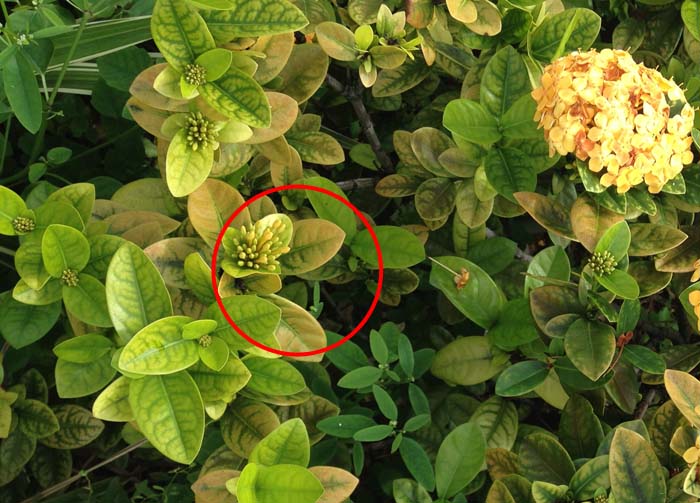When you see brown spots on Ixora leaves do you immediately think oh a leaf spot fungus, when in fact it could be a more common problem caused by…
Podcast: Play in new window | Download
Subscribe: Apple Podcasts | RSS

If you live in South Florida then you may have noticed that everywhere you go there are Ixora’s planted, and they either have this pale yellow-green sickly color or they have these rust colored spots all over their leaves like if they were diseased and not to mention they are dropping leaves and some have even died back. Healthy Ixora leaves have a dark green color and colorful flower clusters that bloom year round.
Whether you planted them or you inherited them on your property, you quickly find out that Ixora’s in South Florida are not maintenance free plants they require a lots of attention. From Scale Insects infestations like aphid, wax scale and mealy bugs, to the sooty mold from the excreted honeydew of the scale insects, to a very common but often misunderstood and misdiagnosed condition known as Chlorois.
Clorosis is a condition where the plant can’t produce Chlorophyll, when most people think of Chlorophyll they think it is only the stuff that gives it its green color but it is much more than that. Chlorophyll is used in photosynthesis, this is using the sun’s solar energy and converting it into chemical energy, That chemical energy is Sugar or Glucose, but it can’t photosynthesis because it doesn’t have or can’t produce Chlorophyll. AHHHHHH
It’s missing two primary micro-nutrients Iron and Manganese, this is the most common problem with acid loving plants in South Florida with high ph soils or calcareous soils, the soils contain a high levels calcium carbonate that binds the micronutrients to the soil making them inaccessible to the plant, even when you fertilize with traditional granular fertilizers, because most of the micronutrients become bound to the soil. This can be a hair pulling experience. Ixora’s are acid loving plants they prefer a soil ph of about 5 to 6.5, our soil range from 7.4 to 8.4.
Here comes the Cavalry.
Since most of these micro nutrients tend to be bound by the soils you need to be able to feed them to the plant in a way the plant can access them.
Open wide here come the micronutrient plane.
Chelated micronutrient foliar spray is the most widely used and inexpensive practice in agriculture to correct micronutrient deficiencies, since micronutrients are consumed by the plant minute quantities, and provides and immediate response to the plant, but as the saying goes easy come easy go, the response is short-lived and repeat applications are required, also foliar toxicity can occur from the use of salt, so it must be applied in small doses.
How does it get into the plant?
Chelated Micronutrients that are applied directly to the leaves as a foliar spray must penetrate 3 barriers of the leaf, the waxy cuticle covering the epidermal cells, the cell wall and the plasma membrane of the epidermal cells. Penetration of nutrients through the cuticle occurs by diffusion through “holes” in the cuticle that are water-friendly . Penetration through the plasma membrane occurs by active transport, a process requiring energy.
Problems with absorption.
The age of the leaf seems to affect the cuticle thickness. Young leaves have been shown to absorb more. So in older leaves the correction might not take place and thus only the younger leave should develop without the deficiency or spots.
How chelates work?
The word Chelates comes from the Greek word chele meaning claw, think of it as a lobster claw. Chelation occurs when a metal nutrient ion is encircled by the larger organic molecule (the lobster claw), usually called a ligand or the chelator. Chelated micronutrients are protected from oxidation, precipitation, and immobilization in certain conditions because the organic molecule (the ligand) can combine and form a ring encircling the micronutrient. OK That is the best I can do to explain that in a simple manner.
Pruning
To keep Ixora’s flowering annual pruning is the best in early spring, avoid repeat shearing off tips and branches with mechanical sheers as it removes emerging flower buds.
Mulching
It is best to place about a 3” organic mulch bed around them, try to keep the mulch from bulging around the trunks.
So what to do?
If you want your Ixora’s to look their best, then do what I do, I use 12-4-12 palm pro fertilizer as a foliar spray to all my clients Ixora’s, yes you read correctly 12-4-12 palm pro fertilizer, Along with 22-0-16 that I use as a root drench every 3 months in combination with a 12-4-12 foliar spray every 3 months. The combination of macro and micro nutrients makes it the perfect fertilizer combination for Ixora’s grown in South Florida Soils. About the foliar toxicity resulting because of salts, it is greatly reduced due to its low salt index and the 22-0-16 has no phosphorous a major contributor to water pollution also the nitrogen is environmentally friendly using an 82% slow release nitrogen . Awesome!
To purchase 12-4-12 Palm Pro and 22-0-16 please contact us at 786-222-7069













